
Digital Commerce 2.0: Disrupting the Californian Giants
Amazon, Google, Apple, eBay/PayPal and Facebook are the big five brokers of digital commerce. But the disruption caused by the rise of mass-market smartphones, and the personal data they generate, means the medium-term leadership of these California-based companies is not assured. Each of them has weaknesses that could hinder their progress towards securing a strong strategic position in the new Digital Commerce 2.0 marketplace, and render them potentially vulnerable to competition from telcos, banks and/or start-ups. (October 2013, Executive Briefing Service, Dealing with Disruption Stream.) Digital Commerce 2.0 Gap

